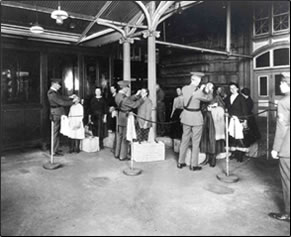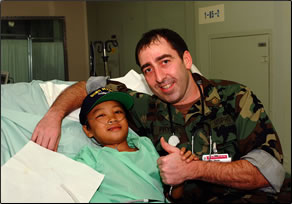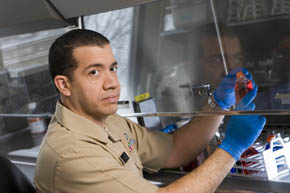History
For more than 200 years, the U.S. Public Health Service Commissioned Corps has been our Nation's frontline protecting against the spread of disease from sailors returning from foreign ports, maintaining the health of immigrants entering the country and supporting communities affected by natural and manmade disasters. The Corps response to the health threats posed by Hurricane Katrina, the earthquake in Haiti, the Deepwater Horizon oil spill, and other recent disasters underscores the value to our Nation of having a highly trained, multidisciplinary, and quickly mobilized cadre of medical professionals. Today, the Corps fights for better public health on multiple fronts. Corps officers are involved in disease control and prevention, biomedical research, regulation of food and drugs, mental health and drug abuse, and health care delivery. As a vital part of the U.S. Public Health Service, the Commissioned Corps is an essential component of the largest public health program in the world.
Commissioned Corps Timeline
- 1798—John Adams, second president of the United States, signed into law the Act for the Relief of Sick and Disabled Seamen. A year later, Congress extended the Act to cover every officer and sailor in the U.S. Navy. The Act led to the gradual creation of a loose network of locally controlled marine hospitals along coastal and inland waterways.
- 1870—Hospital administration was centralized in the Marine Hospital Service, with its headquarters in Washington, DC, under the position of supervising surgeon (later Surgeon General).
- 1871—John Maynard Woodworth, the first supervising surgeon, adopted a military model for his medical staff as part of system reform. Woodworth instituted examinations for applicants, put physicians in uniforms, and created a cadre of mobile, career-service physicians who can be assigned to various marine hospitals.
- 1878—The prevalence of major epidemic diseases such as smallpox, yellow fever, and cholera spurred Congress to enact the National Quarantine Act to prevent the introduction of contagious and infectious diseases into the United States. Congress later extended the Act to prevent the spread of disease among the states. The task of controlling epidemic diseases through quarantine and disinfection measures, as well as immunization programs, fell to the Marine Hospital Service.
- 1889—Legislation formalized the Commissioned Corps as the uniformed services component of the Marine Hospital Service. Congress organized Corps officers along military lines, with titles and pay corresponding to Army and Navy grades.
- 1902—Name of the Marine Hospital Service expanded to Public Health and Marine Hospital Service to reflect growing responsibilities. The Service now carried out the medical inspection of arriving immigrants, such as those landing at Ellis Island in New York, as well as former State quarantine responsibilities. Commissioned Corps officers played a major role in fulfilling the Service's commitment to preventing disease from entering the country.
- 1912—Name of the Public Health and Marine Hospital Service shortened to the Public Health Service (PHS). Legislation enacted by Congress broadened the powers of the PHS by authorizing investigations into human diseases (such as tuberculosis, hookworm, malaria, and leprosy), sanitation, water supplies, and sewage disposal.
- 1930 and 1944—Corps officers expanded to include engineers, dentists, research scientists, nurses, and other health care specialists, as well as physicians.
- Today—The Commissioned Corps continues to fulfill its mission to protect and promote the public health of our Nation. With more than 6,500 active-duty officers, the Corps is working to create a global world free of preventable disease, sickness, and suffering.
 |
Disease control
A Public Health Service physician at Ellis Island inspects an immigrant for trachoma, which entailed inverting the eyelid with a buttonhook, early 20th century. Photo courtesy of the National Library of Medicine (Office of the Public Health Service Historian)
|
 |
Emergency response
On deployment in Indonesia, Commander Thomas Pryor, a nurse, helps care for a young survivor of the 2004 Asian tsunami.
|
 |
Biomedical research
Scientists and researchers in today’s Commissioned Corps continue a proud tradition: conducting biomedical, clinical, behavioral, and epidemiological research.
|
For further information on the history of the Public Health Service and the Commissioned Corps, see Ralph Williams, The United States Public Health Service, 1798–1950 (1951); Bess Furman, A Profile of the United States Public Health Service, 1798–1948 (1973); and Fitzhugh Mullan, Plagues and Politics: The Story of the United States Public Health Service (1989).
Page Last Modified on 11/22/2011
This page may require you to download plug-ins to view all content.